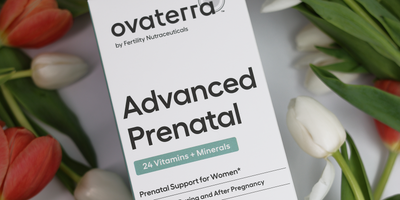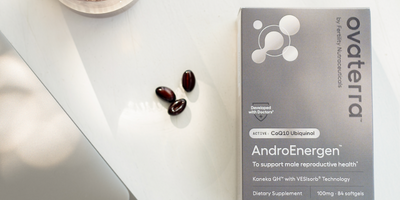What is luteal phase?
To put it simply, luteal phase is the second half of your menstrual cycle. Menstrual cycles are divided into two phases: The first half, from the start of your period to ovulation, is called the follicular phase. This is when the follicles and eggs contained inside go through the final maturation push toward ovulation.
The second half of the menstrual cycle, from ovulation until the start of your next period (or a pregnancy), is the luteal phase. The name “luteal” comes from corpus luteum. It's a temporary structure that the empty follicle morphs into after ovulation. Corpus luteum secretes key hormones for luteal phase.
What happens during luteal phase?
For women who are looking to get pregnant, luteal phase is a crucial period. This is the time in your cycle when the endometrial lining thickens, blood vessels develop and the uterus gets ready to welcome an implanting embryo.

Several things happen during luteal phase to facilitate the start of a pregnancy:
- The mature egg that left the ovarian follicle during ovulation enters and travels down the fallopian tubes to – hopefully – meet the sperm for fertilization within the fertile window.
- After ovulation, corpus luteum releases a few important reproductive hormones, chief among them progesterone.
- Progesterone is responsible for the development and maintenance of the endometrium, so it’s ready to welcome and nurture a fertilized egg (embryo). Progesterone also helps modulate the mom’s immune system so it doesn’t attack the embryo as an invader.
- If the ovulated egg fertilizes and implantation occurs, certain cells of the embryo secretes hCG (human chorionic gonadotropin, the hormone that pregnancy tests detect). hCG signals to the corpus luteum to keep producing progesterone to maintain the pregnancy.
- If a pregnancy doesn’t occur, the corpus luteum decays, and endometrial lining is shed in the next period.
How long should luteal phase be?
There is no one-size-fits-all schedule for different phases of a menstrual cycle, as cycle lengths and timing of ovulation vary woman to woman - and even cycle to cycle. However, the rule of thumb is that ovulation occurs roughly in the middle of a menstrual cycle. This means that follicular phase takes up roughly the first half of your menstrual cycle and luteal phase takes up roughly the second half.
So, for women with a “typical” 28-day cycle, luteal phase is typically 12- to 14-day long. A normal luteal phase length ranges from 11 to 17 days.
For some women, follicular phase is longer than the luteal phase; the reverse can also be true. While it’s normal to have cycles that are shorter or longer than the “typical” 28 days, it can be problematic when your luteal phase is too short: Without a sustained increase in progesterone levels over 12+ days, the endometrium (the lining of the uterus) doesn’t have enough time to develop a welcoming environment for the embryo.
How do I know if my luteal phase is healthy?
Tracking your menstrual cycles and ovulation is one way to understand your luteal phase without having to visit a doctor's office. There are several ways to track ovulation, and depending on which method(s) you use, the signs of a healthy luteal phase are different.
Understanding your luteal phase via BBT
Basal body temperature (BBT) is a popular method to get in tune with your ovulation and fertile window. When you track your core body temperature at rest (which is your basal body temperature), you’ll notice that your BBT dips slightly just before ovulation, then goes up by about 0.5-1°F as you ovulate. With minor ups and downs, your BBT stays elevated during luteal phase.
This rise in BBT is a reflection of the increased progesterone production by the corpus luteum; progesterone works on the hypothalamus to set the core body temperature a little higher than in the follicular phase.
Your BBT will remain elevated if you get pregnant. If not, your BBT will go back down with your next period. A sustained BBT rise after ovulation of at least a week is a good sign that your progesterone levels remain elevated long enough for the endometrium to get ready for implantation.
Understanding your luteal phase via cervical mucus
Some women pay attention to the color and consistency of their cervical mucus to detect when they are close to ovulation. As you approach ovulation and enter your fertile window, the cervical mucus becomes slippery, wet and transparent like raw egg white. The thinner texture of the cervical mucus helps sperm get past the cervix and efficiently move through the female reproductive tract, toward the egg.
Once you ovulate and enter the luteal phase, you will have much less, almost no cervical mucus, until your next period ends.
While the cervical mucus method can be quite effective in knowing when you are most fertile in your cycle, it’s a little difficult to gauge the health of your luteal phase, based on the changes in cervical mucus alone. If this is your main method of ovulation tracking, you may want to use one of the other methods to understand your luteal phase better.
Understanding your luteal phase via hormone/ovulation test method
One of the easiest ways to track ovulation is to use hormone test strips. Different ovulation tests use different hormones to detect ovulation, but in order to understand your luteal phase health, you’ll want ovulation test kits that measure progesterone levels.
Many ovulation test strips can only give you a positive/negative answer, but some, like Proov Predict & Confirm Kit and Oova Ovulation Tracking Kit actually includes numerical data. These ovulation tracking tests may be a good fit if you are looking to understand the hormonal health of your luteal phase, in addition to knowing when your fertile window is.

Proov, in particular, has a patented method to evaluate your luteal phase, using a urine metabolite of progesterone called PdG. Studies have shown that when women have elevated levels of PdG 3-6 weeks into pregnancy, they are 5 times more likely to have a live birth than women whose PdG levels didn't remain elevated. Proov calls this an ovulation score - it's an easy way to get a sense of how ready your body is for implantation and pregnancy in the days following ovulation.
What can I do to support luteal phase?
If you notice that your luteal phase might be on the shorter end or your progesterone levels don’t stay elevated after ovulation, it's a good idea to consult your doctor. They can test your hormone levels and run other diagnostic tests, figure out what’s happening and come up with a treatment plan, if necessary.
Even when your luteal phase appears to be normal, there are a few things you can do to keep it healthy, like maintaining a healthy Vitamin D level, which has been associated with normal luteal phase lengths. In addition, making sure your nutrition is in tip-top shape can help support your luteal phase:
Supporting progesterone production
Adequate production of progesterone by corpus luteum is key during luteal phase. Studies have suggested that a handful of micronutrients may be important in supporting progesterone production:
- Vitamin B6 and other B vitamins: Studies have found that B vitamins – B6 in particular, but others like folate, too – may help maintain a normal luteal phase length by supporting progesterone production.
- Selenium: Several studies have found this trace mineral to potentially support normal luteal phase length. While scientists don’t know the mechanism yet, some speculate that selenium’s antioxidant functions may play a role.
- Zinc and magnesium: These essential minerals have been suggested to play a role in balancing the two key hormones during luteal phase: Estrogen and progesterone. More magnesium is needed during luteal phase for progesterone production. Some studies have also found that a healthy level of zinc may be necessary for corpus luteum to function normally, with an abundance of zinc transporters found in corpus luteum.
- Vitamin C: Studies have found that this antioxidant may be associated with healthy levels of progesterone, although taking a large amount of Vitamin C during luteal phase may not make a difference in the chances of implantation or pregnancy.
Overall, eating in ways that approximate the Mediterranean diet may be a good idea for your luteal phase health. The Mediterranean way of eating has been suggested as an overall best “fertility diet” for both men and women, and its benefits appear to include healthy luteal phase.
Stabilizing blood sugar levels
Many women feel more hunger and mood swings in luteal phase. This is partly because the blood sugar levels fluctuate more in this phase, with the elevated levels of progesterone pulling down blood sugar levels lower than usual. Focusing on stabilizing your blood sugar levels through diet (nuts, whole grains and other foods can help) and light exercise can help you navigate the ups and downs of luteal phase.
Get to know and support your luteal phase for reproductive health
A normal luteal phase that lasts for 11-17 days with sustained progesterone levels is key to embryo implantation and pregnancy. Get to know the health of your luteal phase through ovulation tracking, and support it with healthy diet with a focus on the key nutrients like Vitamin B6 and Selenium, especially when you are trying to conceive. Please reach out if we can answer any questions about luteal phase - we are with you.












